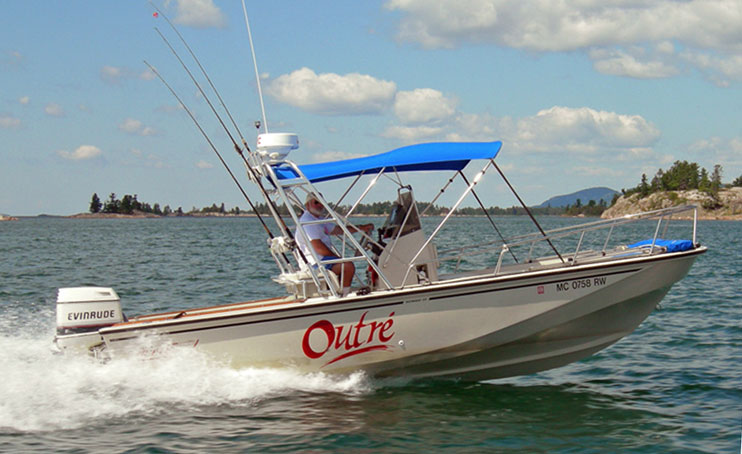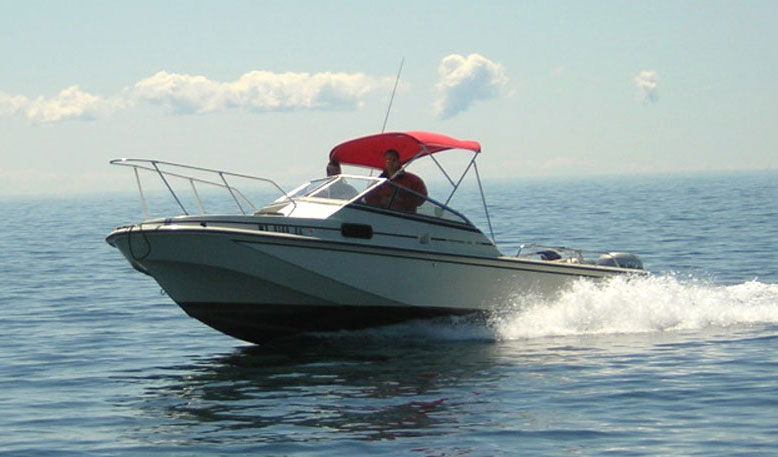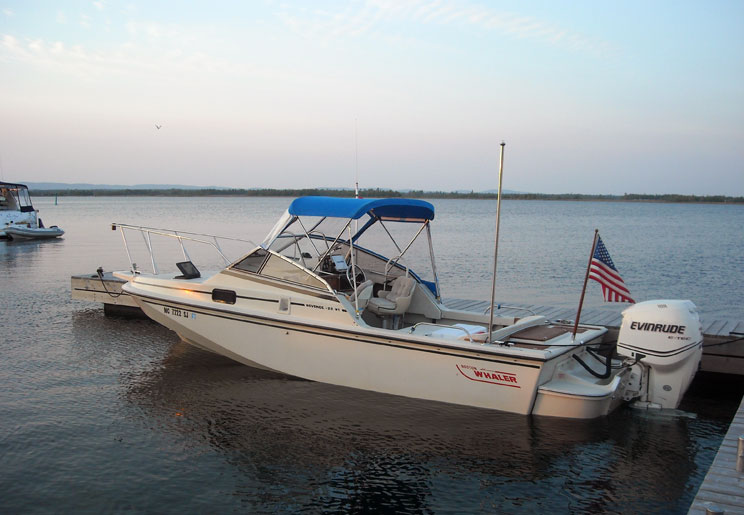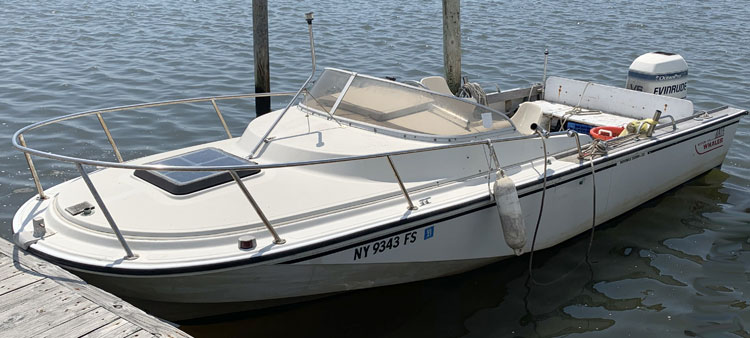
DIMENSIONS (from 1988 Catalogue listings unless otherwise noted)
Length...................... 22-feet 3-inches outboard models
24-feet 2-inches Whaler Drive models
Beam........................ 7-feet 5-inches
Draft....................... 14-inches (with engine tilted clear of water)
Length-to-beam ratio........ 3.00:1 outboard (calculated)
3.26:1 Whaler Drive
Deadrise angle at transom....16-degrees (average of several
measurements)
Weight...................... 2050-lbs Outboard
2300-lbs Whaler Drive
2250-lbs Cuddy
2500-lbs Cuddy Whaler Drive
3050-lbs Sterndrive
Maximum Weight Capacity..... 2,655-lbs Outboard and Whaler Drive
1,850-lbs Sterndrive
Swamped Capacity............ 5,000-lbs
Persons Capacity............ 11-persons
Maximum horsepower.......... 240-HP Outboard
300-HP Whaler Drive
Minimum Horsepower.......... 90-HP
Recommended Shaft Length.... 25-inch single engine; 20-inch twin engine
25-inch Whaler Drive
Fuel Capacity............... 77-gallon integral tank; 129-gallon optional
HISTORY
Designer....................Bob Dougherty and others (presumed)
First year offered..........1979 (as Outrage V-22, then afterwards Outrage 22)
Last year offered...........1993 (this hull may still be available from
Commercial and Government Products division.)
Color.......................1979 to 1993 Desert Tan (reported)
M.S.R.P.....................$ 9,480 in 1979 for Base boat
$17,895 in 1988 for outboard model
$22,495 in 1988 for Whaler Drive model
EQUIPMENT
Standard ................ 77-gallon fuel tank, four forward lockers with
fiberglass covers, after bait well with teak
cover, teak gunwale boards, rod racks, bow eyes,
bow bitt, recessed aft cleats with hawsepipe,
pair of flush rod holders; fiberglass console
with teak access doors, dash panel, door locks,
plexiglas windscreen, stainless steel rail,
mechanical steering with stainless steel wheel,
wiring panel with two pre-wired accessory
switches, fuses and buss bar; fire extinguisher,
navigation lights, stainless steel bow rail.
Notable options.......... Workboat specifications, commercial duty rub rail
bilge pump, compass, Super (Deluxe) Console,
console rod holders, console front seat, coolers,
fire extinguisher recessed pocket, engine
controls (single or dual), OMC, Morse or Mercury;
full width stern seat, outriggers, swivel seat,
Porta-Potti, Reversible Pilot Seat with teak
backrest, springline cleats, stainless steel
side grab rails, console cover, console front
seat cover, reversible pilot seat cover, flying
top set including shelter, boot for shelter, top,
boot for top, windshield, aft curtain, weather
curtain set including Port and Starboard curtains
and drop curtain.
Gunwale options.......... In 1979 to 1991 the gunwales were capped with
teak boards. In 1992 the gunwale boards were
replaced with all-laminated gunwales.
TRANSOM OPTIONS
Outboard.................. 1979 - 1993 notched transom with wide transom
notch for twin outboard engines. The original
models had a narrow engine splash well, called
the sink splash well; in c.1992 the splash well
became full width.
Whaler Drive.............. 1987 - 1993 Whaler Drive added about $4,400
(in 1987) to the price of the outboard boat;
the Whaler Drive allowed mounting more
powerful twin engines and substantially changed
the riding characteristics of the hull.
The Outrage 22 (1979 to 1993) is a true classic among the many models of Boston Whaler boats. When introduced in 1979 it was the largest Boston Whaler hull to date. The catalogue described it as "the most brutally powerful machine ever to bear the Boston Whaler name."
The hull of the Outrage 22 is a moderate V-hull shape that appears to have evolved from the V-20 design. The deadrise at the transom was increased compared to the V-20. The deadrise at the transom is about 16-degrees, based on an average of several measurement by various techniques. The deadrise on the 22-foot hull is greater than on previous hulls designs, but not as great on later designs for larger hulls of similar style, such as the OURAGE 25-foot or 27-foot hulls. This increased deadrise at the transom is said to improve the ride in waves, and at the time of introduction represented Boston Whaler's deepest V-hull design.
The deadrise at the transom is carried forward, increasing slightly amidship, and then increasing significantly at the bow. Whether or not the slight increase in deadrise from transom to amidship disqualifies the hull from being characterized as a constant deadrise design is debatable. V-hulls of this general type, carrying almost the same deadrise at amidships to the transom, are distinct from other hull designs which transition from a V-shape amidship to a much flatter bottom shape with very little deadrise at the transom. In those other hulls there is a very distinct change (decrease) in deadrise of the hull from amidship to transom. In the OURAGE 22 hull the change is small and subtle.
Around this time the designer C. Raymond Hunt was drawing many boats with V-hull shapes often described as constant deadrise, but Hunt (and his associates) contended that there were subtle but important changes in deadrise taking place and the characterization of constant deadrise was not appropriate to their designs. The Hunt website presents objections to their hull design being characterized as having "constant deadrise."
The 22-foot classic hull maintains the general style of Boston Whaler hulls of this period in having a runner or vestigial sponson on each side of the keel. These runners are thought to help deflect spray downward and outboard, and they contribute lift to the hull to help the hull reach hydroplane mode as speed increases. The line of the runners is carried forward, and then turns upward and inward at the bow stem, where the two lines meet and form the characteristic known as the Whaler smirk, from the visual resemblance of the appearance of the boat from head-on to a smile with down-turned corners.
The length to beam ratio of the outboard boat was 3:1, itself a classic ratio in hull design. With the addition of the Whaler Drive, the ratio increased to 3.26:1, becoming one of the highest length-to-beam ratios of any Boston Whaler boat in this era of production.
The cockpit of the Outrage 22 was large and unobstructed, other than the center console. The cockpit was particularly open at the transom where the engine splash well was confined to only a portion of the center of the transom. This permitted anglers to stand all the way aft to the transom at each aft corner of the cockpit. A result of this design was a tendency for waves in a following sea to come over the transom, a frequent occurance if trolling slowly in larger following seas, resulting in seawater entering the aft cockpit. Cockpit sumps with pumps or with open drains could drain water to the sea from the aft part of the cockpit. This tendency was increased if twin engines or particularly heavy engines were used.
The limited width engine splash well is referred to as a sink splashwell. In c.1990 the liner mold was redone, and the OUTRAGE 22 began to have a full-width splash well. This eliminated the problem with water coming over the notched transom and entering the cockpit deck.
An option for larger console, later called the Super Console, was available, creating a wider and longer console. Due to the limited beam of the 22-foot hull, the wider console reduces the clearance on either side.
The Outrage 22 model was introduced with a narrow sink-style splash well that was very deep, with a drain to the sea the deepest part. As a result, there was generally a perpetual accumulation of seawater in the splash well when the boat was in the water if the lower drain was kept unplugged. In subsequent OUTRAGE 20, OUTRAGE 24 and OUTRAGE 25 models which were introduced after the OUTRAGE 22, all of those boats used a shallow but full-width splash well. At the center of the splash well were two drains to the sea. If the boat was in proper trim and the weight on the transom or in the stern was not excessive, then the drains of the full-width splash well would be above the waterline, and the splash well could be dry underway. In c.1990 the liner mold for the OUTRAGE 22 was changed and the full-width splash well was incorporated into the new mold.
The OUTRAGE 20 hull is thought to be nearly identical to the OUTRAGE 22, other than missing two feet of hull in the stern. At one time there were reports considered credible that the two hulls could be made from one mold, but I now believe this is not true. Knowing the complexity of the molds used by Boston Whaler, it seems very unlikey a shorter hull could be created by using some sort of mechanical insert into a mold, nor could the transition from original mold surface to modified mold surface with a shortening insert be accomplished without leaving evidence in the gel coat layer of the molded product taken from the hull.
The aluminum tank was mounted on rubber cushions and mechanically retained in the cavity, usually by an aluminum bar over the top of the tank (or by some arrangement of straps). The tank was then foamed in place to prevent movement. The fuel tank was contained in a central hull cavity which was covered by a laminated and wood-reinforced deck that could be removed if necessary. In typical Whaler fashion, a unique arrangement of a clear access hole cover and a mechanical fuel gauge provided a very nice tank level indictor without using electrical gauges. The fuel tank was fabricated by Florida Marine Tanks. In some years an optional 129-gallon fuel tank was available. If installed, the larger fuel tank eliminated the aft cockpit live well.
The Outrage 22 offered impressive offshore capability, yet its limited beam allowed easily trailering. The boat's shallow draft made it useful inshore, too, adding to its versatility. Although an open boat, it could also be fitted with a complete package of canvas, turning it into a very comfortable foul-weather cabin. The large bow compartment could accomodate over night sleeping, especially under the cozy forward shelter canvas.
The Outrage 22 has a distinctly different hull form than Boston Whaler's earlier Outrage models, the 19 and 21. The earlier boats had a rounded bottom hull at the stern, but the Outrage 22 has a V-bottom. The model designators with odd numbers, 13, 15, 17 (originally 16), 19, and 21, refer to hulls with a rounded bottom. The model designators with even numbers, 18, 20, 22, and 24 (later changed to 25) refer to hulls with moderate V-bottoms, a distinction in the model designations implemented by Bob Dougherty.
The base boat with center console was the Outrage 22. The center console boat with a cuddy cabin was the Outrage 22 Cuddy. The 22-foot hull was also offered as cabin boat as the Revenge 22 and later the Revenge-22 Walk-Through. There was also a non-center-console version called the Revenge Cuddy that has the small cuddy cabin and the helm located very far forward on Starboard behind a small windshield. The 22-foot hull was also available as a Temptation model with Whaler Drive. In some years of production a sterndrive option was also available in many models. The 22-foot hull could also be ordered with a Whaler Drive option, which was primarily seen with twin engine installations. See the comprehensive model and production year chart in the Reference section for a more detailed breakdown of models and years of production.
Models of the 22-foot hull were also available from CPD in various configurations and trim. This hull was particularly popular with the military and has been used as a fast boat for amphibious assualts (littoral) and in riverine operations.
The photographs below show the Outrage 22 and several other model variations.

Fig. 1. This c.1992 Outrage 22 outboard model has a single 225-HP engine on its notched transom. A top speed of close to 50-MPH would be expected. The seating has been modified to an aftermarket leaning post from Birdsall. The large Sun Top is from Wm. J. Mills & Co.. The beautiful radar arch was custom made by Lakeside Marine of Ohio (no longer in business). Photo credit: John F. collection.

Fig. 2. An Outrage 22 Cuddy kept the center console but added a small cuddy cabin. Twin pedestal seats replace the more commonly seen reversible pilot seat. With twin V6 outboards the engine weight was near the limit, as can be deduced by the limited freeboard at the transom of the Whaler Drive.

Fig. 3. The 22-foot hull was also used for the Revenge series. On the notched transom of this Revenge 22 Walk-Through are twin Honda F90 engines; the hull seems to tolerate the substantial transom weight. Photo credit: David B.

Fig. 4. Hulls re-worked for a Whaler Drive have a closed transom and aft storage lockers, as seen here on this 1990 Revenge 22 Walk-Through Whaler Drive. There is ample buoyancy for the weight of modern outboard engines. Access to the foredeck is by the walk-through windshield opening. The canvas is a Mills Flying Top, Windshield, and Side Curtain (here seen only on the Starboard side). A Drop Curtain (not shown) completes the weather canvas set. A wrap-around stern cockpit seat was optional. Photo by the author.

Fig. 5. The Revenge 22 Cuddy was an early cuddy-cabin model with a wrap-around windshield. This model is rarely seen. Photo from jimh collection.
continuousWave --> Whaler --> Reference -->Outrage 22DISCLAIMER: This information is believed to be accurate but there is no guarantee. We do our best!
Copyright © 2018 by James W. Hebert. Unauthorized reproduction prohibited!
This is a verified HTML 4.01 document served to you from continuousWave
This article first appeared October 23, 2018.
Author: James W. Hebert
